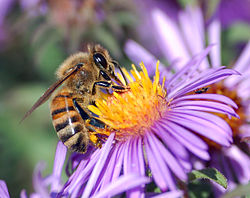
Anthecology, or pollination biology, is the study of pollination as well as the relationships between flowers and their pollinators.[1]: 8 Floral biology is a bigger field that includes these studies. Most flowering plants, or angiosperms, are pollinated by animals, and especially by insects.[2] The major flower-frequenting insect taxa include beetles, flies, wasps, bees, ants, thrips, butterflies, and moths. Insects carry out pollination when visiting flowers to obtain nectar or pollen, to prey on other species, or when pseudo-copulating with insect-mimicking flowers such as orchids.[2]: 282 Pollination-related interactions between plants and insects are considered mutualistic,[2]: 283 and the relationships between plants and their pollinators have likely led to increased diversity of both angiosperms and the animals that pollinate them.[3]: 64
Anthecology brings together many disciplines, such as botany, horticulture, entomology, and ecology.
- ^ Baker, Herbert G (1983). "An Outline of the History of Anthecology, or Pollination Biology". In Leslie Real (ed.). Pollination Biology. Academic Press.
- ^ a b c Gullan PJ, Cranston PS (2005). The Insects: An Outline of Entomology (3rd ed.). Blackwell Publishing. p. 281. ISBN 1-4051-1113-5.
- ^ Campbell NA, Reece JB (2005). Biology (7th ed.). Pearson Benjamin Cummings. ISBN 0-8053-7146-X.